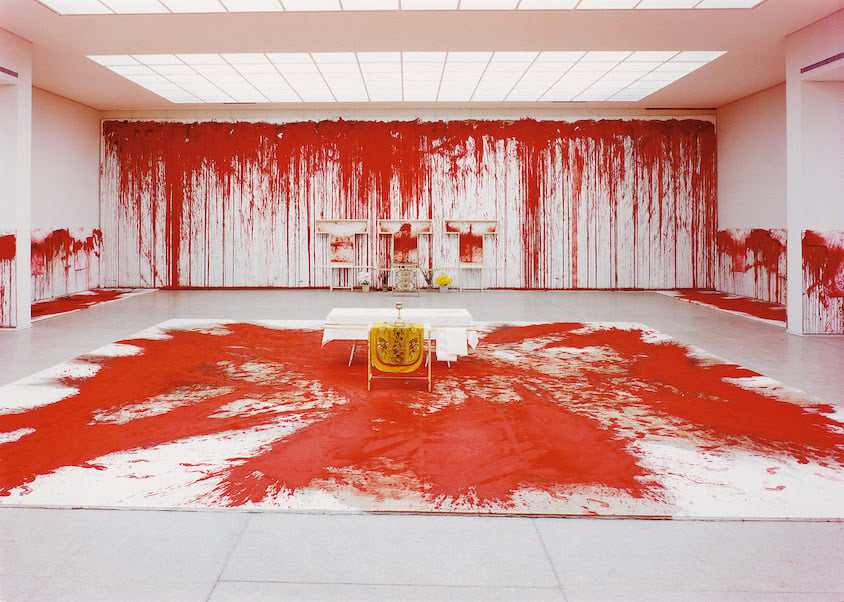Hermann Nitsch – 20th painting action

In occasione della 59. Biennale d’Arte di Venezia, Zuecca Project – spazio non-profit fondato da Alessandro Possati con quartier generale sull’isola della Giudecca – dedica una esposizione a Hermann Nitsch (Vienna, 1938), tra i massimi esponenti dell’Azionismo viennese.
Comunicato stampa
Zuecca Projects announces a major exhibition of artist Hermann Nitsch (b. 1938, Vienna), presented by Helmut Essl’s private collection in collaboration with Galerie Kandlhofer, featuring 20th painting action, which was originally created and presented at the Wiener Secession, Vienna in 1987. The exhibition marks the first time that the entire 20th painting action works will be seen together in Italy since their creation and exhibition and is the artist’s only painting action to remain in one collection. The exhibition will be on view from 19 April to 20 July 2022 at Oficine 800 on the island of Giudecca, Venice during the 59th Venice Biennale.
‘To every age, its art. To art, its freedom’ is the motto, formulated by art critic Ludwig Hevesi (1843–1910), that can be read above the portal of the Wiener Secession in Vienna. Only a few artists have tested the boundaries of freedom so constantly as Hermann Nitsch — and have been harassed and persecuted for it so often, including criminal charges, protests, and threats. Despite all resistance, he hung on to his idea of a fusion of all the arts and stands now as a monolithic figure in 20th century art history. With his ‘Orgies Mysteries Theatre’, he created a total work of art for all the senses; he expanded the traditional parameters of painting and theatre; he brought the cultic, which is located at the beginning of art’s evolution, back into contemporary art; and he blended art with life.
Hermann Nitsch was a pioneering artist of Viennese Actionism whose painting is positioned at the start of his action art. On November 18, 1960, influenced by Art Informel, he carried out his first action art, in which the painting no longer depicts anything outside the picture and rather represents pure colour, direct gesture, and compacted time. His painting shows in a nutshell ‘the visual grammar of the actions on a picture surface’.[1]
As early as 1957, Nitsch worked on the idea of his ‘Orgies Mysteries Theatre’. Influenced by the philosophy of Nietzsche and Schopenhauer, Greek tragedy, and the idea of the total work of art developed by Richard Wagner, he designed a gigantic drama that would last several days. Among the themes he worked into it are the Oedipus story, material relating to the Atreidai, the Christian story of the Passion, and the legend of the Grail and the Nibelungs, in order to superimpose religions and myths on top of one another, like a great cultural collage. The fundamental concern of the broadly arranged mass of ideas that make up his ‘Orgies Mysteries Theatre’ is the intensifying of one’s experience of life, and enhanced joy found in existence as a result, as a mystery of being, whereby art assumes functions carried out by religions. In 1963, he gave up painting for 20 years to dedicate himself exclusively to his actions and to work on the realisation of his ultimate ‘six-day play’.
In early 1980s, Nitsch returned to action painting, something to be seen not only as immanent to the work itself, but also as a critical response to the painting of the ‘New Wild Ones’, who at the time dominated the art market. The 20th painting action which he carried out in the Wiener Secession in 1987 stands out in its importance on account of the scope, quality, and subjective significance that Nitsch attaches to it. With its sacral quality, the central room at the Secession accommodates Nitsch to the extent that he has aspired to ‘the sacralisation of all art’ from the very outset.[2] For him, art is ‘something similar to art’, just as ‘the practice of art corresponds to a ritual’.[3] The ‘Temple of Art’ created by Josef Maria Olbrich in 1898 turns into a stage for a cultic painting action. It is also the fulfilment of a long-cherished desire, for there exists a sketch by Nitsch for an action in the Wiener Secession from as early as 1964.
The works of the 20th painting action in the Wiener Secession reveal impressively their genesis that took place between ‘unleashed outbreaks of fury and delicate gestures’. We are immersed in a pictorial, actionist environment in which the basic constants of his work spread out visually, located between the momentary and the eternal, the dynamically moving and the contemplatively calm, the real and the symbolic, between purity and defilement, excessive demands and reflection.
With the large-format poured painting (5 x 20 m) on the front wall, the large splatter painting (10 x 10 m) lying on the ground, and numerous smaller splatter and poured paintings flanking them, a space-filling panorama is created, illustrating like no other in condensed form the essence of Nitsch’s painting as an integral component of his ‘Orgies Mysteries Theatre’ conceived in a synaesthetic manner.
Nitsch declared: “I wanted to show how the spilling, squirting, smearing, and splashing of red-coloured liquid can evoke a sensorily intense arousal in the viewer, inviting sensorily intense sensations”[4]. As part of his comprehensively conceived ‘Orgies Mysteries Theatre’, the painting action is intended to trigger in the public a heightened experience of sensory reality, ideally leading to reflection on one’s own existence.
The renewed integration of all the works from the 20th painting action in the historical space of the Oficine 800 on the island of Giudecca not only enables a recapitulation of his most important works; it also allows Hermann Nitsch’s artistic ideas located between the ecstatic and the contemplative to be re-traced and re-experienced.
About Hermann Nitsch
Hermann Nitsch was born on August 29, 1938 in Vienna. He is a co-founder of Viennese Actionism and, alongside Allan Kaprow, Joseph Beuys or Günter Brus, is among the international pioneers of Performance Art. As an actionist, painter, graphic artist, stage set designer, writer, and composer, he is one of the few contemporary universal artists. The ‘Orgies Mysteries Theatre’ conceived and developed by him is the realization of his idea of the total work of art, in which all the human senses are employed. In 1971, he succeeded in acquiring Schloss Prinzendorf in Lower Austria for his OM Theatre, in which he was able in 1998 to realise his ultimate 6-day play after decades of preparation. Since 2007, a museum in Mistelbach has been dedicated to him, presenting his work in ever-new facets. Nitsch has been exhibited at documenta many times and has been represented at the Biennale in Venice and in Sydney. He has carried out more than 150 actions worldwide and received retrospectives in the Van Abbe Museum, Eindhoven; the Lenbachhaus, Munich; the Martin Gropius Bau, Berlin; and the Albertina, Vienna.
Works by Hermann Nitsch can be found in the most important collections and museums in the world, including the Museum of Modern Art, New York; the Guggenheim Collection, New York; the Metropolitan Museum, New York; the Tate, London; the Centre Georges Pompidou, Paris; the Stedelijk Museum, Amsterdam; the Castello die Rivoli; the GAM, Turin; the Mart, Rovereto; the Kunstsammlung Nordrhein-Westfalen, Düsseldorf; the Museum Ludwig, Cologne; the Nationalgalerie Berlin; the Lenbachhaus, Munich; the Staatsgemäldesammlung Munich; the Staatsgalerie Stuttgart; the Kunsthalle Hamburg; the Kunstmuseum Bern; the Kunstmuseum Winterthur; the Albertina, Vienna; mumok, Vienna; and the Österreichische Galerie Belvedere, Vienna; Leopold Museum, Vienna.
About Wiener Secession, Vienna
The Vienna Secession was founded in 1897 by artists such as Gustav Klimt, Koloman Moser, Josef Hoffmann, and Joseph Maria Olbrich as a splinter movement from the conservative Vienna Künstlerhaus, based on the model of the Munich Secession. One year later, the striking building of the Secession in the heart of Vienna was built according to plans of the Otto Wagner student Josef Maria Olbrich. In the Secession, works by Paul Cézanne, Claude Monet or Vincent van Gogh were shown for the first time in Austria. To this day, the Vienna Secession remains a vital exhibition venue for contemporary art in Austria.
About Zuecca Projects
Zuecca Projects is a non-profit cultural organization involved in the conception, creation, and development of interdisciplinary projects in the realms of contemporary art, architecture, and film. It is a collaborative platform which allows for artist, curators, private and public institutions, galleries, and private sector companies to engage and interact to produce cultural projects with world-leading representatives from their respective sectors.



